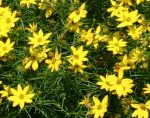 Threadleaf coreopsis is a rhizomatous herbaceous perennial and a member of the aster family, Asteraceae, that also includes daisy, sunflower, and lettuce. It is native to southeastern US where it grows in open woodlands in full sun and on variable soil. The dense bushy plants grow 1-3′ tall and have branched wiry stems with 2-3″ long sessile leaves that are palmately divided into threadlike segments. The 1-2″ wide flower heads are carried singly on slender stalks in loose corymbs from late spring to fall and consist of yellow unnotched ray flowers surrounding yellow disc flowers. Deadheading prolongs bloom and shearing in late summer encourages a good fall display. Due to its drought tolerance, long bloom time, disease and pest resistance, and long life, threadleaf coreopsis is a very popular garden plant for borders, cottage gardens, and naturalized areas. The genus name, Coreopsis, comes from the Greek words koris meaning bug and opsis meaning like/similar to and refers to the appearance of the seed. The specific epithet, verticillata, is the Latin word for having whorls and refers to the arrangement of the leaves.
Threadleaf coreopsis is a rhizomatous herbaceous perennial and a member of the aster family, Asteraceae, that also includes daisy, sunflower, and lettuce. It is native to southeastern US where it grows in open woodlands in full sun and on variable soil. The dense bushy plants grow 1-3′ tall and have branched wiry stems with 2-3″ long sessile leaves that are palmately divided into threadlike segments. The 1-2″ wide flower heads are carried singly on slender stalks in loose corymbs from late spring to fall and consist of yellow unnotched ray flowers surrounding yellow disc flowers. Deadheading prolongs bloom and shearing in late summer encourages a good fall display. Due to its drought tolerance, long bloom time, disease and pest resistance, and long life, threadleaf coreopsis is a very popular garden plant for borders, cottage gardens, and naturalized areas. The genus name, Coreopsis, comes from the Greek words koris meaning bug and opsis meaning like/similar to and refers to the appearance of the seed. The specific epithet, verticillata, is the Latin word for having whorls and refers to the arrangement of the leaves.
Type: Herbaceous perennial
Bloom: One to two inch wide flower heads from late spring to fall consisting of yellow ray flowers surrounding yellow disc flowers
Size: 1-3′ H x 2-3′ W
Light:Full sun
Soil:Fertile to lean, medium moist to dry, well-drained
Hardiness: Zones 3-9
Care: Deadhead to promote flowering; shear in late summer for fall rebloom
Pests and Diseases: Generally healthy but susceptible to slug and snail damage, aphids, root rot,mildews, leaf spot, aster yellows, Botrytis blight
Propagation: Seed (species), division, cuttings
Companion Plants:Phlox, cranesbill, Salvia, blanket flower, purple coneflower
Outstanding Selections:
‘Golden Showers’ (18-24″ tall, 2.5″ bright yellow flowers)
‘Grandiflora’ (taller and with larger flowers than species)
‘Moonbeam’ (2′ tall, sulphur yellow flowers)
‘Zagreb’ (1-1.5′ tall, dark yellow flowers